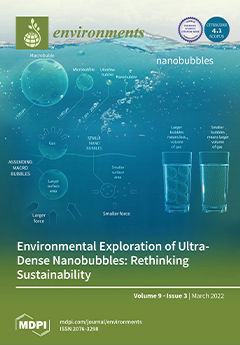The abundant presence of fluoride (F
-) in surface water bodies is an environmental concern because of its effects on human health; medical reports confirmed that fluoride intake above 1.5 mg/L leads to many health complications, including but not limited to weak
[...] Read more.
The abundant presence of fluoride (F
-) in surface water bodies is an environmental concern because of its effects on human health; medical reports confirmed that fluoride intake above 1.5 mg/L leads to many health complications, including but not limited to weak bones and enamel fluorosis. Thus, the World Health Organisation (WHO) defines 1.20 mg/L as the maximum permissible F
- concentration in drinking water. The electrocoagulation method (EC) is globally practised to remove many pollutants from water due to its cost-effectiveness, safety, and ease of use. However, EC has some drawbacks, such as the lack of reactors’ design. In this study, a new EC reactor, which uses four drilled aluminium electrodes and a variant cross-section section container, was designed and used to remove F
- from water. The design of the new EC eliminated the need for water mixers. The ability of the new EC unit to remove F
- from synthetic water was evaluated at different current densities (CD) (1–3 mA/cm
2), electrode distances (ELD) (5–15 mm), pH of the solution (pHoS) (4–10), and initial F
- concentrations (IFC) (5–20 mg/L). The outcomes of this study prove that the new reactor could remove as much as 98.3% of 20 mg/l of F
- at CD, ELD, pHoS, and IFC of 2 mA/cm
2, 5 mm, and 4 and 10 mg/L, respectively.
Full article





